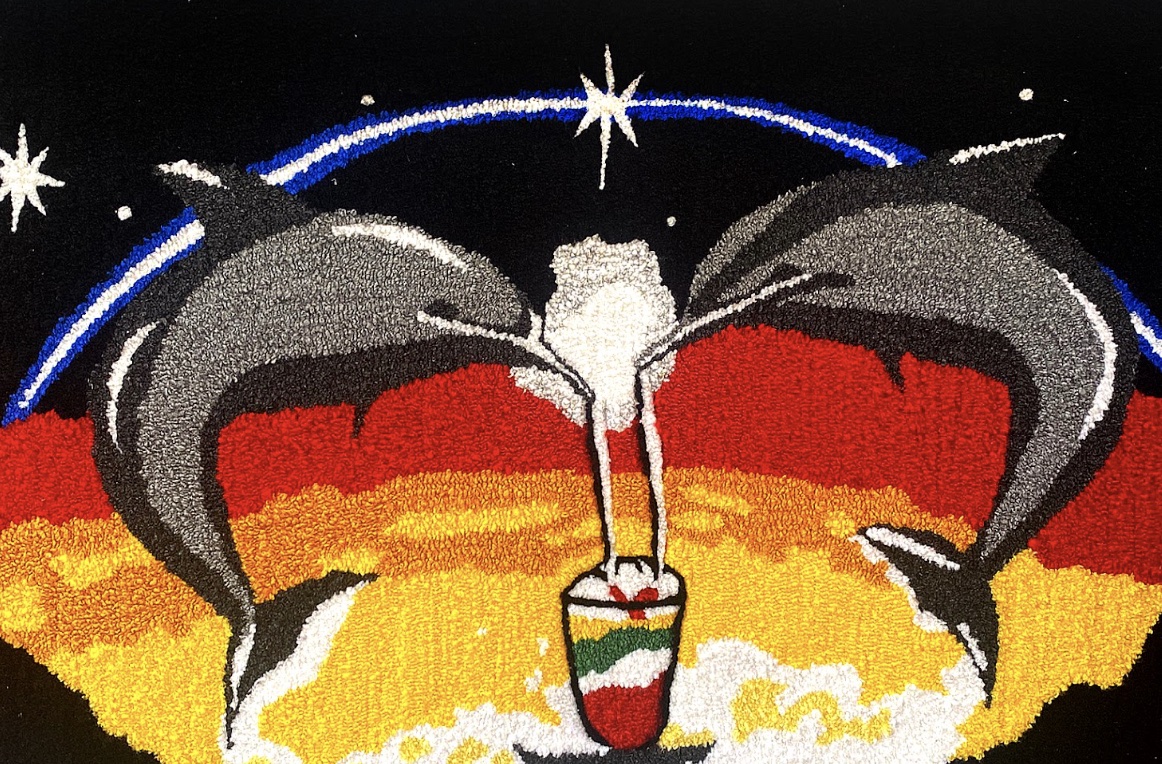
Ricardo Passaporte
Say No to the Dolphin Show
Exhibition
-> Aug 17 2024 – Sep 28 2024
General Expenses presents the exhibition Say No to the Dolphin Show by Ricardo Passaporte.
The Discomfort of Comfort: on the work of Ricardo Passaporte
In 1910, Henri Rousseau paints “The Waterfall”. We see a lush green, verdant and alive jungle. Trees of many kinds, succulents and the occasional mauve overgrowth. In the centre stand two alert deer, looking in opposite directions. Nearby, two men are in states of observation; one watches the deer as if to interact with them, and one seemingly hiding in the leaves looking in an unknown direction. This is a scene of time standing still. Everything seems warm, the heat emanates from the canvas. It is of particular interest that it is unclear if the deer or the men are the protagonists of this painting. They coexist and do not subjugate one another. Also presented here is the biophilic possibility, the love that humans may possess for nature and other living beings on the planet, and particularly in the wild. Art historians classify Rousseau’s work within the category of naive art. Thus, works which have within them and in their construction frankness, and a diversion from the formal qualities of painting, something simple, and even childlike. Such works can also border on folk art, but still remain in the canon of fine art. That said, Rousseu’s sincere and direct approach positions him as a torch bearer of the movement. Other artists who hold to the movement include: Niko Pirosmani, Hilma af Klimt, Seraphine Louis, Marc Chagall, and Frida Kahlo among others. This is a field of references which situates the work of Ricardo Passaporte.
Drawing from photographs which are then transferred into paintings, Passaporte uses animals, scenes from sites of play, and various figures caught in moments of presence. Animals, figure strongly as one of the motifs that the artist explores. Perhaps these subjects allow for a painting to be shifted out the register of the anthropomorphic, or the human, and therefore in some sense of the redundant. When choosing the content to paint, the artist follows the path of least resistance, in the sense of avoiding a particular limiting method of decision making and opting for resonance. This brings to mind the notion from Bergson of “Intuition as method”. Deleuze in his “Bergsonism” analyses thoroughly, Bergson’s key notions of duration, memory, and élan vital. Deleuze empathises that intuition is a method of ‘precision’ that follows a set of ‘strict rules’. This figures strongly into Bergson’s metaphysics as such: “Intuition is neither a feeling, an inspiration, nor a disorderly sympathy, but a fully developed ethos, on of the most developed methods in philosophy.”Furthermore, investigating how philosophers trace the lines of their logic 1 and insight can enter into an equation which validates intuition. Passaporte’s process can be considered within these terms.
Additionally, there is an aspect to the artist’s work which is tragicomic. Notes of humour and irony intermingle with seriousness, melancholy, and even here and there a highly political subject. Thus, the viewer is offered an entrance into their sensitivity on these topics and an access into these affective states by spectating. Fundamentally, this is a body of work which makes us both very comfortable and very uncomfortable simultaneously. Such a chance for paradox through experience is the vitality of art.
Ricardo Passaporte’s artistic practice questions the nature of creation taking into account mass production, utilizing acrylic and spray paint, his distinct blurring style creates a dream-like aura, exploring the symbolic nature of imagery as a metaphor for the human experience. Drawing inspiration from everyday objects, advertising, branding, and popular imagery, his works challenge traditional artistic values and play with the codes of painting. Passaporte’s paintings delve into daily life and the absurd in a saturated digital world filled with the mundane.
Passaporte’s work draws attention to the hand-drawn, homespun nature of their creation by referencing Outsider Art and engaging with the repetitiveness and impulsivity of graffiti. The artist explores the symbolic nature of found images and uses this material as inspiration to inform his practice. Passaporte takes an interest in and raises questions about the nature of making art, as well as the dichotomies between the mass-produced and the uniquely singular art object.
Ricardo Passaporte (b. 1987, Lisbon, Portugal) lives and works in Lisbon. He is a graduate of Universidade da Beira Interior, Covilhã, where he studied Fashion Design. Passaporte has curated and published several catalogues with Germes Gang and Stolen Books Publications.
His work has been presented at Câmara Municipal do Porto, Porto; L21, Palma de Mallorca; Steve Turner, LA; Michael Horbach Foundation, Cologne; Vestjyllands Kunstpavillion, Videbæk; Huset for Kunst og Design, Holstebro; Ruttkowski68, Paris; Eduardo Secci, Florence; Annarumma, Naples; and Museu do Côa, Vila Nova de Foz Coa.
— General Expenses